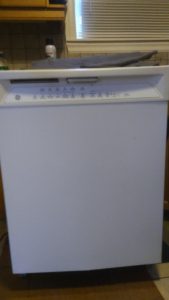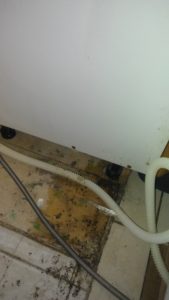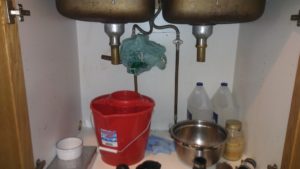
My old dishwasher after we finally got it out from under the kitchen counter.
“Ah, the joys of homeownership!” It’s a familiar phrase homeowners utter during moments of frustration. When you buy a home, you’re buying all the good and the bad that comes along with it.
Home repairs and renovations are often overlooked by new homeowner, but I can tell you first firsthand that’s a big mistake. They can easily add up and cost you a pretty penny. In my second year as a homeowner, I ended up spending about $25,000 on home renovations. And then there was that surprise $1,300 furnace repair bill earlier this year.
Sometimes you can plan for home renovations and repairs, such as a new roof. Other times they happen totally out of the blue like my most recent home renovation: replacing my dishwasher.
A Flooded Basement
A month ago I got an email from my tenants mentioning that the dishwasher was leaking upstairs (I live in the basement of my house and rent up the upstairs to my tenants). This wasn’t good news and it couldn’t have come at a worse time, right before I was about to do my holiday shopping (doesn’t it always happen this way when you’re a homeowner?). I was hoping it wasn’t anything major or costly – maybe the dishwasher filter was clogged. It was late Friday evening, so I wasn’t going to go upstairs and take a look until the following morning. Then it happened.
I was downstairs working on the computer when I suddenly heard rushing water. I didn’t like the sound of it – and it was coming from the laundry room! I hurried to find that water had leaked from the dishwasher upstairs through the floorboards to the laundry room downstairs. The good news is that the flood happened in the laundry room, so the damage was minimal. The flood was also pretty small, so I was able to clean it up with a mop and some towels.

The mice chewed right through the drain hose on my dishwasher and left a “mess” behind.
On Saturday morning I went upstairs to see why the dishwasher flooded. Now, I’m the first to admit, I’m no Mike Holmes, but I at least wanted to see if I could figure out what happened before calling in an expert. I looked inside the dishwasher to see if the filter was clogged, but no dice. I removed the dishwasher’s kick plate to take a look underneath. Unfortunately, I couldn’t see what caused the flood, so I decided to move the dishwasher from under the kitchen counter. I didn’t think this would be a tough job. Boy, was I wrong!
I started by taking out the screws securing the dishwasher to the kitchen counter. That was pretty easy! All that was left was to slide out the dishwasher and take a look behind it. And this is where the “fun” part came in. I went to slide out the dishwasher, but it wouldn’t budge. Upon closer inspection, I noticed that the dishwasher was sitting on the original linoleum kitchen flooring, which was about an inch lower than my kitchen tiles. This was a problem. A big problem!
When I moved into my house, one of the key selling features was the newly-renovated kitchen. The only problem is that the contractors didn’t know what they were doing. They installed the kitchen tiles after installing the dishwasher. This is fine as long as the dishwasher never has to be removed (fat chance!). By installing the kitchen tiles in front of the dishwasher, the dishwasher was trapped under the kitchen counter. I tried screwing up the dishwasher’s feet, but there still wasn’t enough clearance to move the dishwasher from under the counter.
As a homeowner, I was faced with a tough decision to remove the dishwasher.
Option 1: Damage the kitchen tiles in my newly-renovated kitchen.
OR
Option 2: Cut the kitchen counter and ruin my countertop.
Both of these options weren’t ideal to say the least. Option 1 seemed the least destructive, so I was about to go with it, when I came up with a third option…
Option 3: Use wooden splints to pry up the kitchen counter.
Now, I can’t take full credit for this idea. My dad, who’s a real handyman, came up with the brilliant idea. There was just enough space between the countertop and cabinets to place wooden splints. After the splints were in place, with all our might, my step-mom and I tried to pull the dishwasher out from under the counter. It took a good 20 minutes, but we finally got it out. Eureka!
I got down on my hands and knees to look behind the dishwasher to see what had caused the leak. It didn’t take me long to figure it out. Mice had gotten behind the dishwasher and chewed through the plastic drain hose.
Some Things are Best Left to Professionals

Epic DIY plumbing fail.
Before I could handle the rodent issue, I had something more pressing to attend to. I didn’t notice it right away, but something else happened when we removed the dishwasher from under the counter. The kitchen sink started to leak. My father’s handy around the house and always does his own plumbing, so I thought it would be a quick fix. Boy, was I wrong, again! What started out as a small home reno was quickly becoming a major one.
Since the sink broke on the weekend when plumbers typically charge double time, we decided to try to fix it ourselves. My dad took a look at my tenant’s kitchen sink and decided that the plumbing was all wrong and took the sink apart. We went to Home Depot to buy plumbing parts for what was supposed to be a “quick job.” We ended up spending 8 hours on Saturday and another 8 hours on Sunday for a total of 16 hours with nothing to show. Not only were we unable to fix the kitchen sink, we actually made it worse. My tenants weren’t happy to be without a kitchen sink for two days, so I called in a plumber the next day.
When you’re a homeowner, it helps to have home repair professionals on speed dial. I called New Canadian Drain & Plumbing and they stopped by the very next day. When hiring a professional, it’s important to ask about the charges ahead of time. I assumed all plumbers charge an hourly rate, but that wasn’t the case with this plumber. I was charged a rate per job. To replace the baskets in my two kitchen sinks and the plumbing underneath it, it cost me nearly $800. To say that I was shocked by the high repair bill would be the understatement of the century. But I had no choice, so I paid it. (In hindsight, it probably would have been smarter to call around to other plumbers and get two or three quotes, but it was a plumbing emergency, so I didn’t have a lot of time.)
Once the kitchen sink was repaired, I took care of the next pressing problem: getting rid of the mice in my house. I knew mice were destructive, but never in my wildest dreams did I think that they would climb up through the walls and chew through the drain hose in my dishwasher. I hired an exterminator to handle the problem. He inspected my house for mouse entry points, sealing them up with steel wool, and put bait stations and traps throughout my place. The exterminator ended up costing $325, but if it gets rid of the mice problem, it will be well worth it. (It’s a drop in the bucket compared to how much damage mice can cause in your home.)
Buying a New Dishwasher
Once the mice problem was taken care of, the only thing left to do was repair/replace the dishwasher. I had a heck of a time getting the dishwasher out from under the counter, so I decided that putting the old dishwasher under the counter wasn’t an option.
I took measurements for a new dishwasher. The opening under the counter was slightly over 33.5 inches in height. I had a tough time finding a dishwasher that would fit under my counter. Most dishwasher require at least 34 inches in clearance for height.
After doing my research online and calling around, I found a model at Home Depot that was only 33.5 inches in height. The width and depth were fine as well. (Be sure to take measurements in store. I found different measurements on the same model when visiting retailer websites.) Lucky for me, this particular model was on clearance. I read the reviews online and it seemed fine.
I ended up scoring a great deal. I had the choice between a stainless steel model for $350 or a white model for $600. I went with the stainless steel model. I visited the store in person and took final measurements and it fit. I purchased the dishwasher and paid an extra $60 for delivery and $145 for installation. (I could have tried to install the dishwasher myself, but after the DIY plumbing fiasco earlier, I decided to leave it to the experts this time.)
I thought the hard part was over and that the installation would go smoothly. Unfortunately, that didn’t happen, either. The installers ran into a couple problems that I didn’t anticipate. The first was that the floor underneath the dishwasher wasn’t perfectly level. The installers asked me if I had anything to level the floor, but I didn’t. Luckily, they were able to adjust the feet on the new dishwasher to level it out.
The second problem was to do with the power source. The installers asked me where the special powerline coming from the wall for the dishwasher was. I told them I didn’t have one and didn’t know what they were talking about. They told me that, apparently, on new models, you need a powerline running from your power outlet to the dishwasher. The good news is that they could convert my new dishwasher to make it work the “old fashioned way.” The bad news is that it was going to cost me. I wouldn’t mind if it was $10 or $15, but it was an extra $50!
I was livid. I refused to pay. I told the installers that Home Depot should have asked me at the store about the power outlet. How was I to know? I’m not a dishwasher expert. I politely, but firmly stood my ground. Initially, the installers threatened to leave my house without installing the dishwasher and told me to take it up with Home Depot. I told them that this wasn’t an option. I took the day off work to be present for the installation. Besides, my tenants needed a dishwasher over the holidays.
Nobody Cares More About Your Money Than You
After standing my ground, the installers finally caved and said that they would convert the power cord without charging me an extra $50 because Home Depot failed to properly explain it to me. Phew! But this got me thinking. How many other people did the installers pull this with? This really seemed like a scam to me and taught me a valuable lesson: you really need to stick up for your money because nobody cares more about your money than you. (I was once almost charged $90 for a water heater service call, but similar to this situation, I was able to avoid it.)
This experience also reminded me of the importance of having an emergency fund. How was I know that a leaky dishwasher would lead to almost $2K in home repairs and expenses? Luckily, I had the cash on hand to pay for this surprise expense without going into debt. Unfortunately, homes are full of surprises.
The best way to avoid going into debt is to sock away three to six months’ worth of living expenses in a high-interest savings account. If you can’t afford to save that much initially, don’t feel discouraged. Save $50 a month or whatever you can afford and before you know it, you’ll have a rainy day fund. Because when it rains, it often pours, especially for homeowners.
Sean Cooper is the bestselling author of the book, Burn Your Mortgage: The Simple, Powerful Path to Financial Freedom for Canadians, available now on Amazon and at Chapters, Indigo and major bookstores, and as an Audiobook on Amazon, Audible and iTunes.
Great post Sean! Good thing you had extra money to take care of the emergencies! I also experienced three major financial emergencies in December 2017. My dishwasher, fridge and car of 17 years needed to all be replaced to the tune of $20K. It was a major shock, but I had the money in an emergency account to pay for these things. Thank you for writing about the importance of having an emergency fund!
Now you have a new problem. I doubt the guys doing the electrical hookup were electricians, sounds like the electrical connections do not conform to code and the work was not inspected and approved by the Elictrical Inspection Authority in your province.
Instead of keeping the emergency fund in cash or in interest bearing account, I have set up a line of credit to use in an emergency. I invest the emergency fund and get a much better return than the interest on my line of credit. When possible I sell my investments and pay off the line of credit.
I’m house hunting and am leary of recently renovated houses because there are so many flippers and 2 bit contractors out there. I think I’d rather get the work done when I least I can choose who does the work. I know there are no guarantees there either, bit at least I have some idea of what’s been done and I don’t mind getiing my hands dirty to check stuff before all the poor work gets drywalled up and hidden away.